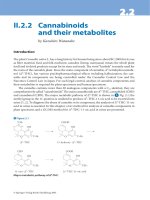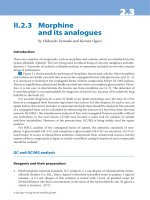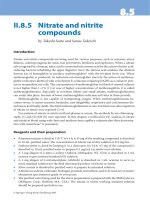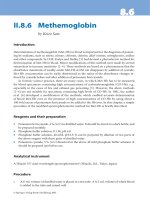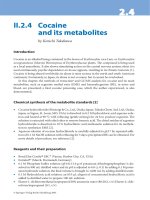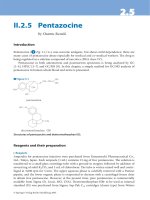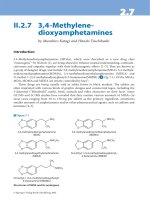Drugs and Poisons in Humans - A Handbook of Practical Analysis (Part 67)
Bạn đang xem bản rút gọn của tài liệu. Xem và tải ngay bản đầy đủ của tài liệu tại đây (309.9 KB, 9 trang )
8.28.2
© Springer-Verlag Berlin Heidelberg 2005
II.8.2 VX and its decomposition
products
by Munehiro Katagi and Hitoshi Tsuchihashi
Introduction
An organophosphorus nerve agent VX ( O-ethyl S-2-diisopropylaminoethyl methylphosphono-
thiolate,
> Figure 2.1) shows potent inhibitory action on acetylcholinesterase; its develop-
ment, production, stockpiling and use are being prohibited by the CWC international treaty as
a chemical weapon together with those of sarin and soman. In addition, even material com-
pounds for VX synthesis are being also controlled strictly.
In the world history, there had been no records on the use of VX in any international dis-
pute. However, in December 1994, a murder terrorism incident using VX committed by a cult
group took place in Osaka, Japan. e very high poisoning potency of VX proven in the inci-
dent surprised the whole world with a shock and anxiety.
VX is easily hydrolyzed under alkaline conditions, and also in the environmental water and
soil to produce ethylmethylphosphonic acid (EMPA) and further methylphosphonic acid
(MPA) [1]. VX is rapidly hydrolyzed by both chemical and enzymatic reactions in mammalian
bodies to produce EMPA and 2-(diisopropylaminoethyl)methyl sul de ( DAEMS)
a
. ese
metabolites or decomposition products are detected for veri cation of the use of VX [2].
Many methods for EMPA and MPA mainly in environmental water and soil were reported
using ion chromatography with indirect photometric detection [3], capillary electrophoresis
[4], GC/MS a er methylation [5], silylation [6–8] and penta uorobenzyl (PFB) derivatization
[9, 10], LC/MS [11] and CE/MS [12, 13] both without any derivatization, LC/MS a er deriva-
tization and LC/MS/MS [14]. In actual terrorism cases using VX, the detection of its metabo-
lite products from urine and blood is essential. In this chapter, the details for GC/MS analysis
of VX metabolites in human serum
b
are described.
Structures of VX and its hydrolyzed products/metabolites.
⊡ Figure 2.1
620 VX and its decomposition products
Reagent and their preparation
• A 10-mg aliquot of EMPA (Aldrich, Milwaukee, WI, USA) is dissolved in 10 mL distilled
water (1 mg/mL) to prepare aqueous stock solution. Just before use, the solution is appro-
priately diluted with blank human serum to prepare the standard specimens.
• A 10-mg aliquot of DAEMS is dissolved in 100 mL distilled water to prepare aqueous stock
solution (100 µg/mL). Just before use, the solution is appropriately diluted with blank
human serum to prepare the standard specimens. DAEMS can be synthesized by reacting
2-(diisopropylamino)ethyl chloride hydrochloride
c
(Aldrich) with sodium thiomethoxide
(Aldrich) [2].
• A 10-mg aliquot of diphenylmethane (DPM, internal standard = IS, Aldrich and other
manufacturers) is dissolved in 100 mL acetonitrile (100 µg/mL).
• N-Methyl-N-(tert-butyldimethylsilyl)tri uoroacetamide + 1 % tert-butyldimethylchlo-
rosilane (Pierce, Rockford, IL, USA) is directly used for tert-butyldimethylsilyl (t-BDMS)
derivatization.
• A 1-mg aliquot of 2-(diisopropylaminoethyl)methoxide (DAEMO, IS) is dissolved in 100 mL
dichloromethane (10 µg/mL). DAEMO can be synthesized by reacting 2-(diiso propyl-
amino)ethyl chloride hydrochloride with sodium methoxide (Aldrich and other manufac-
turers) [2].
• Other reagents are of the highest purity commercially available.
GC/MS conditions
GC column: a DB-1 fused silica capillary column (30 m × 0.32 mm i.d., lm thickness 0.25 µm,
J&W Scienti c, Folsom, CA, USA).
GC/MS conditions
d
; instrument: a Shimadzu QP5050 gas chromatograph connected with
a mass spectrometer (Shimadzu Corp., Kyoto, Japan); column (oven) temperature for EMPA:
80 °C (2 min) 15 °C/min 300 °C; column (oven) temperature for DAEMS: 50 °C (2 min)
10 °C/min 300 °C; injection temperature: 270 °C; injection mode: splitless; interface tem-
perature: 250 °C; EI electron energy: 70 eV; CI reagent gas: isobutane.
Procedures
i. Analysis of VX and its volatile metabolite [2]
i. A 1-mL volume of serum is mixed with 1 mL dichloromethane, shaken and centrifuged;
the dichloromethane layer is transferred to another test tube. To the above aqueous phase,
1 mL dichloromethane is again added, shaken and centrifuged.
ii. e resulting dichloromethane layers are combined and dehydrated by adding anhydrous
Na
2
SO
4
. e clear dichloromethane solution is transferred to a glass vial and carefully
evaporated to dryness under a stream of nitrogen gas at room temperature
e
.
iii. e residue is dissolved in 100 µL of the dichloromethane solution of DAEMO (IS solu-
tion); a 1-µL of it is injected into GC/MS for analysis
f
.
621VX and its decomposition products
ii. Analysis of EMPA [2, 8]
i. e remaining aqueous layer in the above procedure 1) is mixed with 1 mL acetonitrile and
centrifuged for deproteinization
g
.
ii. e resulting supernatant solution is mixed with 1 mL of 0.05 M oxalate bu er solution
(pH 1.68)
h
, 0.6 g NaCl and 2 mL acetonitrile
i
, shaken and centrifuged. e resulting ace-
tonitrile layer is transferred to another test tube. To the remaining aqueous phase, 2 mL
acetonitrile is again added, shaken and centrifuged.
iii. e acetonitrile layers obtained are combined, dehydrated with anhydrous Na
2
SO
4
; the
clear acetonitrile layer is transferred to a Pyrex test tube
j
, and evaporated to dryness under
a stream of nitrogen with heating at 60 °C.
iv. e residue is mixed with 100 µL of N-methyl-N-(tert-butyldimethylsilyl)tri uoroacet-
amide + 1 % tert-butyldimethylchlorosilane and heated at 60 °C for 30 min for t-BDMS
derivatization
k
.
v. To the above reaction mixture, 20 µL of the diphenylmethane (IS) acetonitrile solution is
added and mixed; a 1-µL aliquot of it is subjected to GC/MS analysis
l
.
Assessment of the method
> Figure 2.2 shows a total ion chromatogram (TIC), a mass chromatogram measured at
m/z 114 and EI and CI mass spectra
m
for DAEMS (500 ng/mL) extracted from human serum.
If VX remains, it is extracted into the dichloromethane layer; however in most cases except
for massive VX exposure, VX cannot be detected, because of its rapid metabolism and decom-
position in human bodies.
e detection limits of DAEMS in serum are about 50 ng/mL in the scan mode and about
5 ng/mL in the SIM mode.
> Figure 2.3 shows a TIC, mass chromatograms and mass spectra
n
for EMPA (1 µg/mL)
extracted from human serum. In humans, who have been exposed to VX, MPA also appears
together with EMPA in serum. However, in the present method, the extraction e ciency of
MPA is as low
o
as several %; only a trace level of MPA can be detected or it is not detectable in
most cases. It should be pointed out that MPA can be equally produced from some organo-
phosphorus nerve agents, such as sarin and soman; the detection of only MPA does not enable
speci cation of a chemical weapon used. e identi cation of EMPA is most important to
verify the exposure to VX.
e detection limit of EMPA in human serum is about 10 ng/mL in the scan mode and
about 1 ng/mL in the SIM mode.
Usually, for qualitative analysis of organophosphorus nerve agents, the detection and iden-
ti cation of their metabolite alkyl methylphosphonic acid are carried out. In the VX poisoning
cases, DAEMS due to the leaving group can be detected together with EMPA; the detection of
both compounds highly enhances the reliability for veri cation of VX exposure.
622 VX and its decomposition products
Poisoning case, and toxic and fatal concentrations
VX is much less volatile than sarin, but is highly permeable through the skin; usually victims
are exposed to an aerosol or a liquid form of VX. e absorption of VX through the eye mucosa
and the skin results in its poisoning.
In the murder terrorism with VX taking place in Osaka, Japan, 1994, VX was sprayed on
the back of the neck of the victim using a syringe (the exposure amount not known); he died
10 days later. As VX poisoning symptoms, marked miosis and lowered levels of cholinesterase
activity characteristic for organophosphorus compound poisoning appear rst; in severer
poisoning, dyspnea, enhanced sweating, convulsion attack, respiratory arrest and nally cardio-
pulmonary arrest leading to death can be observed.
VX is said to be the most potent poison among the nerve agents. ere are no precise data
on the toxicity of VX in humans; there are only estimated values based on the experimental
GC/MS analysis for DAEMS in serum. (a) a total ion chromatogram (TIC) and a mass chromato-
gram; (b) an EI mass spectrum of DAEMS; (c) a CI mass spectrum of DAEMS.
⊡ Figure 2.2
623VX and its decomposition products
data of animals. According to the reports by the US army [15,16], the minimal toxic and lethal
concentrations of VX via the airway are said to be 1.1 × 10
–5
mg · min/m
3
and 0.1 mg · min/m
3
,
respectively. According to a report by WHO [17], the percutaneous lethal doses of VX are
estimated to be 2–10 mg.
In the above VX- poisoned victim, VX could not be detected from his serum, which had
been sampled 1 h a er the exposure; however EMPA and DAEMS, the metabolites of VX, could
be detected [18].
GC/MS analysis for EMPA in serum. (a) a TIC and mass chromatograms; (b) an EI mass spectrum of
the t-BDMS derivative of EMPA; (c) a CI mass spectrum of the same derivative of EMPA.
⊡ Figure 2.3


